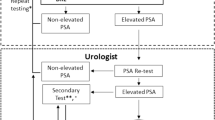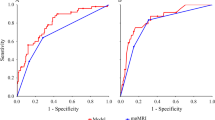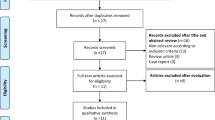Abstract
Ca 15-3 is an aspecific tumor marker characteristic of cancer proliferation. Elevated serum levels seem to be closely correlated with cancer progression in non-urological tumors. This study assessed the role of Ca 15-3 as an aspecific tumor marker in patients with borderline prostate-specific antigen (PSA) biochemically suspected of prostate cancer (PCa) and with multiple negative prostate biopsies.
The study is based on prospective analysis of 103 patients: (a) 33 patients (group A) presented lower urinary tract symptoms secondary to BPH with normal serum PSA values, DRE and TRUS negative for suspected PCa; (b) 31 patients (group B) with histologically diagnosed PCa; (c) 39 patients (group C) with borderline serum PSA values, DRE and TRUS normal, two ultrasound (US)-guided random prostate biopsies negative for PCa. Ca 15-3 was determined in the entire study series by the IRMA method, using as range the values proposed for the investigated non-urological tumors (38 UI/l).
Ca 15-3 was within normal range in all group A patients (control), while the values were elevated in 27/31 of group B patients (PCa) and in 11/39 of group C (PCa suspected) patients. A third biopsy was performed in all 39 group C patients with borderline PSA and it was PCa-positive in 13 patients (33.3%, subgroup C3). In this series Ca 15-3 was increased in 9 of 13 patients (subgroup C3α), while the remaining four patients (subgroup C3β) presented values within the normal range. On 26 group C patients who were negative for PCa to third biopsy (subgroup C4), 24 patients had Ca 15-3 levels within normal range (subgroup C4α) with histologic findings of BPH in 23 cases and granulomatous chronic prostatitis in one case, while two patients (subgroup C4β) had elevated Ca 15-3 concentrations associated with lymphoplasmacytic chronic prostatitis.
We hypothesize that Ca 15-3, as a specific tumor marker, could be an interesting and inexpensive second step diagnostic tool for PCa in patients with borderline PSA and multiple negative prostate biopsies, as it could indicate whether a repeated biopsy should be performed in a short time, having excluded other concomitant tumors. However, further prospective studies will be necessary to confirm this hypothesis.
This is a preview of subscription content, access via your institution
Access options
Subscribe to this journal
Receive 4 print issues and online access
$259.00 per year
only $64.75 per issue
Buy this article
- Purchase on Springer Link
- Instant access to full article PDF
Prices may be subject to local taxes which are calculated during checkout

Similar content being viewed by others
References
Luthgens M . Definition. In Luthgens M, Schlegel G (eds). Clinical Use of Tumor Marker System Leonberg: Tumor Diagnostic. 1989. pp. 3–4.
Oesterling JE, Chan DW, Epstein JI, Kimball AW Jr, Bruzek DJ, Rock RC, Brendler CB, Walsh PC . Prostate specific antigen in the preoperative and post-operative evolution of localized prostate cancer treated with radical prostatectomy. J Urol 1998; 139: 766–772.
Hudson MA, Bahnson RR, Catalona WJ . Clinical use of prostate specific antigen in patients with prostate cancer. J Urol 1989; 142 (4): 1011–1017.
Catalona WJ, Smith DS, Ratliff TL, Dodds KM, Coplen DE, Yuan JJ, Petros JA, Andriole GL . Measurement of prostate specific antigen in serum as a screening test for prostate cancer. New Engl J Med 1991; 324 (17): 1156–1161.
Crawford ED, DeAntoni EP . PSA as a screening test for prostate cancer. Urol Clin N Am 1993; 20 (4): 637–646.
Glenski WJ, Malek RS, Myrtle JF, Oesterling JE . Sustained substantially increased concentration of prostate specific antigen in the absence of prostatic malignant disease: an unusual clinical scenario. Mayo Clin Proc 1992; 67 (3): 349–352.
Chu TM . Prostate specific antigen and early detection of prostate cancer. Tumour Biol 1997; 18 (2): 123–134.
Cohen R, Zucchelli GC, Fraysse M, Pilo A, Rigault MY, Grillet S, Bizollon CA . ‘Oncocheck’: an international external quality assessment scheme for immunoassays of tumor markers. Nucl Med Biol 1994; 21 (3): 483–493.
Kruse R, Geilenkeuser WJ, Rohle G . Interlaboratory surveys of the determination of tumour markers scatter and repeatability of the results. Eur J Clin Chem Clin Biochem 1993; 31 (3): 139–146.
Alivizatos G, Dimopoulos A, Mitropoulos D, Alevizou K, Bougas D, Pantazopoulos D . Efficacy of eight serially measured markers for diagnosis of prostatic carcinoma. Arch Esp Urol 1992; 45 (3): 269–272.
Lopez LA, Del Villar V, Ulla M, Fernandez F, Fernandez LA, Santos I, Rabadan L, Gutierrez M . Prevalence of abnormal levels of serum tumour markers in elderly people. Age Ageing 1996; 25 (1): 45–50.
Jacobs EL, Haskell CM . Clinical use of tumor markers in oncology. Curr Probl Cancer 1991; 15 (6): 299–360.
Bieglmayer C, Szepesi T, Kopp B, Hoffmann G, Petrik W, Guettuoche K, Grundler S, Gregorits M, Strasser M . Ca 15-3, MCA, CAM26, CAM29 are members of a polymorphic family of mucin-like glycoproteins. Tumour Biol 1991; 12 (3): 138–148.
Lotzniker M, Pavesi F, Scarabelli M, Vadacca G, Franchi M, Moratti R . Tumour associated antigens CA 15.3 and CA 125 in ovarian cancer. Int J Biol Markers 1991; 6 (2): 115–121.
Author information
Authors and Affiliations
Corresponding author
Rights and permissions
About this article
Cite this article
Falsaperla, M., Morgia, G., Giammusso, B. et al. Role of Ca 15-3 in patients with biochemically suspected prostate cancer and multiple negative ultrasound-guided prostate biopsies. Prostate Cancer Prostatic Dis 6, 45–49 (2003). https://doi.org/10.1038/sj.pcan.4500615
Received:
Revised:
Accepted:
Published:
Issue Date:
DOI: https://doi.org/10.1038/sj.pcan.4500615



